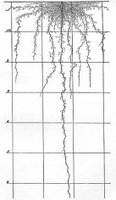Some plant species do the opposite of saving for a rainy day. They sop up rain water that would otherwise run off or evaporate. They redistribute the water to a long tap root where it is safely stored in deep soil out of reach of their shallower rooted neighbors. In the intervals between rainy periods, they return water to the shallow portion of the root system and prevent it from drying out. Researchers indicate that this capability is not restricted to
the tree species in the the Amazon basin they researched. While the researchers refer to the "hydraulic redistribution" phenomenon being observed by others, first in small plants two decades ago, this appears to be the first time that a statement has been offered to gage the potential global scale and the significance to water balance and climate models.

The new study in the Amazonian forest shows that trees use water in a complex way: The tap roots transfer rainwater from the surface to reservoirs deep underground and redistribute water upwards after the rains to keep the top layers moist, ... The researchers estimate this effect increases photosynthesis and the evaporation of water from plants, called transpiration, by 40 percent in the dry season, when photosynthesis otherwise would be limited.
"This shifting of water by roots has a physiological effect on the plants, letting them pull more carbon dioxide from the atmosphere as they conduct more photosynthesis," said co-author Todd Dawson, professor of integrative biology at UC Berkeley. "Because this has not been considered until now, people have likely underestimated the amount of carbon taken up by the Amazon and underestimated the impact of Amazonian deforestation on climate."...
Dawson, Lee and their colleagues, including Inez Fung of UC Berkeley, reported their findings last month in the Dec. 6 issue of the Proceedings of the National Academy of Sciences. ...
"Evapotranspiration stays higher than previously expected during the prolonged dry season because of this private reserve of water banked during the wet season by the tap roots," said Dawson. "Just as perspiration cools us off, increased transpiration by trees in June and July explains the drop in temperature in the Amazon."
This effect changes the way the atmosphere heats and cools, and will change the way rain is distributed, he noted. Depending on the extent to which trees elsewhere in the world, especially in Africa and other tropical and extratropical areas, redistribute water in the soil, the impact on global climate could be significant.
"The impact on transpiration is greatest in the Amazon and Congo forests, but our model also shows an impact in the United States and other places that have dry and wet periods," Lee said.
Trees have long been known to lift water from the soil to great heights using a principle called hydraulic lift, with energy supplied by evaporation of water from leaf openings called stomata. Twenty years ago, however, some small plants were found to do more than lift water from the soil to the leaves - they also lifted deep water with their tap root and deposited it in shallow soil for use at a later time, and reversed the process during the rainy season to push water into storage deep underground. Dawson discovered in 1990 that trees do this, too, and to date, so-called hydraulic redistribution has been found in some 60 separate deeply rooted plant species.
Earlier this year, Dawson's colleague and former UC Berkeley doctoral student Rafael Oliveira of the Laboratório de Ecologia Isotópica at the University of Sao Paulo, Brazil, discovered that Amazonian trees also use hydraulic redistribution to maintain the moisture around their shallow roots during the long dry season. During the wet season, these plants can store as much as 10 percent of the annual precipitation as deep as 13 meters (43 feet) underground, to be tapped during the dry months. [emphasis added]
Oliveira of the Laboratório de Ecologia Isotópica at the University of Sao Paulo, Brazil, discovered that Amazonian trees also use hydraulic redistribution to maintain the moisture around their shallow roots during the long dry season. During the wet season, these plants can store as much as 10 percent of the annual precipitation as deep as 13 meters (43 feet) underground, to be tapped during the dry months. [emphasis added]
"These trees are using their root system to redistribute water into different soil compartments," Dawson said. "This allows the trees and the forest to sustain water use throughout the dry season."
The process is a passive one, he noted, driven by chemical potential gradients, with tree roots acting like pipes to allow water to shift around much faster than it could otherwise percolate through the soil. In many plants that exhibit hydraulic redistribution, the tap roots are like the part of an iceberg below water. In some cases these roots can reach down more than 100 times the height of the plant above ground. Such deep roots make sense if their purpose is to redistribute water during the dry season for use by the plant's shallow roots, though Dawson suspects that the real reason for keeping the surface soil moist is to make it easier for the plant to take in nutrients.
"Hydraulic redistribution is definitely related to water, but it can't really be discussed outside the context of plant nutrition," he said.
The article goes on from there, but this point concerning nutrition is worth expanding upon. The article indicates that stored water is transferred to the shallower portion of the root system where it must exude into the soil "for keeping the surface soil moist". Soil ion adsorption and plant nutrient exchange processes are moist (vs dry) soil phenomena. Keeping the soil moist just at the root surface would put minimal demand on plant water reserves but have a significant effect on nutrient availability.
It would also support the symbiotic community of soil microorganisms supported by the root system. Arbuscular mycorrhizal fungi and symbiotic soil bacteria are sustained by rhizodeposition, a term which can encompass both liquid root exudates and solid plant cell material. In my experience, root exudates are normally explained as simply an energy or carbon source for the microbes, a carbohydrate quid-pro-quo in exchange for mineral nutrients. It is a fairly thrifty exchange. The water supply component of root exudates highlighted in this new research is an exciting emphasis, at least to your author. Access to steady and stable supply of water, even a parsimonious supply, is ideal for sustaining soil fungi. Resulting beneficial effects, in the form of mycorrhizal hyphae, can extend out from a few centimeters to many meters. Perhaps future observations will be able to determine if the fungi component also plays a role in moistening soil.
Root water uptake and the dynamic availability of water to plants is a phenomenon that tends to be overlooked by soil scientists, despite the often dominant role of roots as a sink for water in the soil.
quoted from: Roots: The big movers of water and chemical in soil. Clothier, BE; Green, SR. Soil Science. Vol. 162, no. 8, pp. 534-543. Aug 1997.
Color photo is from http://earthobservatory.nasa.gov/Laboratory/ICE/Images/panama_canopy.jpg Line drawing to left is Fig.113.--Root of sunflower where plants were spaced 8 inches apart. From
Line drawing to left is Fig.113.--Root of sunflower where plants were spaced 8 inches apart. From Root Development of Field Crops. Weaver, John. 1926 posted at
http://www.soilandhealth.org/
Line drawing in middle of article is from
How a Tree Grows, FS-32, 1970, USDA Forest Service
Key:
(A) Tap Root — Provides main support of tree and anchors it firmly in the ground. (Not all trees have one)
(B) Lateral Roots — Help support and anchor trunk, may extend far out, beyond crown spread.
(C) Fibrous Roots — Masses of fine feeding roots close to ground surface.
(D) Deeply Descending Roots (‘Sinkers’) — Grow downward from lateral roots
EurekaAlert! news release for cited articleUPI news release for cited articleTechnorati Tags:
Soil science Environment Water Soil Microbiology Science
 Precision ag implies computer mapped lab data and GPS controlled field equipment. Higher yields, less flying blind and easier farming. The reality is that the expense of data collection, analysis and interpretation can quickly wipeout any added value. Reading this article about variable rate management of cotton, it struck me that common sense and curiosity are the missing ingredients. Elton Robinson with Delta Press reports on cotton producer Kenneth Hood, Mississippi, who attributes his success with variable rate agriculture to, among other things, reliance on aerial photo interpretation, an approach not typical of precision agriculture. Hood says that the “... advantage to imagery is that very little data collection is required, according to Hood, “which is unlike most precision agriculture practices.” Put this experience together with the recent cryptic news on the lukewarm record of precision agriculture in Germany, which I touched on earlier, and what do you get? My sense is that Kenneth Hood is going to have lots of company.
Precision ag implies computer mapped lab data and GPS controlled field equipment. Higher yields, less flying blind and easier farming. The reality is that the expense of data collection, analysis and interpretation can quickly wipeout any added value. Reading this article about variable rate management of cotton, it struck me that common sense and curiosity are the missing ingredients. Elton Robinson with Delta Press reports on cotton producer Kenneth Hood, Mississippi, who attributes his success with variable rate agriculture to, among other things, reliance on aerial photo interpretation, an approach not typical of precision agriculture. Hood says that the “... advantage to imagery is that very little data collection is required, according to Hood, “which is unlike most precision agriculture practices.” Put this experience together with the recent cryptic news on the lukewarm record of precision agriculture in Germany, which I touched on earlier, and what do you get? My sense is that Kenneth Hood is going to have lots of company.















